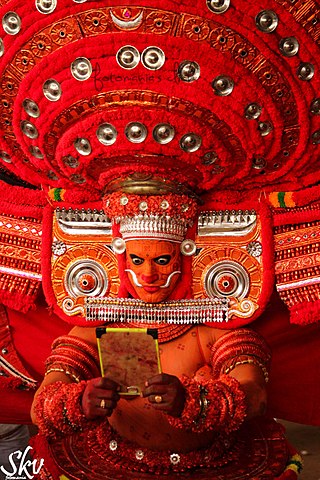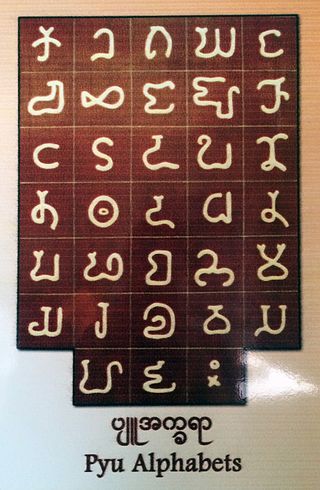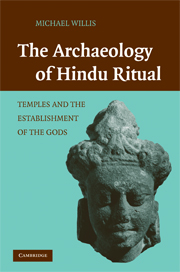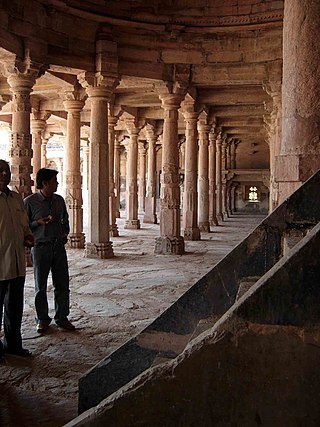
Samye, full name Samye Mighur Lhundrub Tsula Khang and Shrine of Unchanging Spontaneous Presence, is the first Tibetan Buddhist and Nyingma monastery built in Tibet, during the reign of King Trisong Deutsen. Shantarakshita began construction around 763, and Tibetan Vajrayana founder Guru Padmasambhava tamed the local spirits for its completion in 779. The first Tibetan monks were ordained there. Samye was destroyed during the Cultural Revolution then rebuilt after 1988.

Theyyam is a Hindu religious ritual practiced in northern Kerala and some parts of Karnataka. Theyyam is also known as Kaḷiyāṭṭaṁ or Tiṟa. Theyyam consists of traditions, rituals and customs associated with temples and sacred groves of Malabar. The people of the region consider Theyyam itself as a channel to a god and they thus seek blessings from Theyyam.

Halasi is a town in Khanapur Taluk, Belgaum District in Karnataka, India. It is 14 km from Khanapur and about 25 km from Kittur. As known from inscriptions, the ancient name of the town was Palāśikā. A centre of the early Kadamba Dynasty, it was a minor capital of the Goa Kadambas (980-1025). The town is notable for a series of medieval temples. The most famous are the Varāha Narasiṃha temple and Suvarṇeśvara temple in the town, and a third temple of Rāmeśvara. On a hill about 1.9 km. south-west of the town is a pilgrimage place known as Rāmatītha.

Bhojpur is a town of historical and religious importance in Raisen District of Madhya Pradesh, India.

The Pyu language is an extinct Sino-Tibetan language that was mainly spoken in what is now Myanmar in the first millennium CE. It was the vernacular of the Pyu city-states, which thrived between the second century BCE and the ninth century CE. Its usage declined starting in the late ninth century when the Bamar people of Nanzhao began to overtake the Pyu city-states. The language was still in use, at least in royal inscriptions of the Pagan Kingdom if not in popular vernacular, until the late twelfth century. It became extinct in the thirteenth century, completing the rise of the Burmese language, the language of the Pagan Kingdom, in Upper Burma, the former Pyu realm.

The Bhojshala is an historic building located in Dhar, Madhya Pradesh, India. The name is derived from the celebrated king Bhoja of the Paramāra dynasty of central India, a patron of education and the arts, to whom major Sanskrit works on poetics, yoga and architecture are attributed. The architectural parts of the building proper are of different periods but mainly date the 12th century; the Islamic domed tombs in the wider campus were added between the fourteenth and fifteenth centuries.
Arjunavarman was an Indian king from the Paramara dynasty, who ruled in the Malwa region of central India.

The Archaeology of Hindu Ritual: Temples and the Establishment of the Gods is an archaeological study focusing on the early development of Hinduism within the Gupta Empire between the 4th and 6th centuries CE. It was written by the British archaeologist Michael D. Willis who was the curator of the South Asian and Himalayan collection at the British Museum at the time of the book being published by Cambridge University Press in 2009.

The Tosham rock inscription, dating from the 4th or 5th century, on Tosham hill in Tosham town of Haryana state in India, is an epigraph documenting the establishment of a monastery and the building of water tanks for followers of the Satvata in ancient Yadava Kingdoms. They also built the Kalayat Ancient Bricks Temple Complex and may have been vassals of the Satavahana dynasty, which disintegrated into smaller kingdoms in the 3rd century, during the Gupta Empire.

The Ambikā Statue from Dhār is a marble figure in high relief of the Jain goddess Ambikā in the collection of the British Museum, London. The sculpture was discovered in the city of Dhār, central India, in the nineteeth century. The figure is famous for its inscription in Sanskrit on the base that provides a link to the Paramara dynasty and the court of king Bhoja. The Ambikā has been part of the British Museum's collection since 1909.

The Tomb of Shaykh Changāl is a domed shrine or rauza located on the southern ramparts of the old circular city of Dhar, Madhya Pradesh. It is also referred to as Chālis Pīr because it marks the site where a group of early émigrés were attacked and killed by a mob while at prayer. Local residents identify a circular tank, just west of rauza, as the place where their remains were dumped.
Sihoniya is a town in Morena district, in the Indian state of Madhya Pradesh. The town is sometimes referred to as Suhania; in medieval times it was called Siṃhapānīya. The settlement has a long history and a number of notable monuments, one being of national importance and protected by the Archaeological Survey of India.

Lat Mosque is a mosque in Dhar in Madhya Pradesh, India. Named after the Iron pillar of Dhar, it is also known as Lat ki masjid, Ladh Masjid, or Lath Masjid.
Nūr al-Dīn Muḥammad Ẓuhūrī was a Persian poet born around 1537. Ẓuhūrī states that he was born in Qāʾin, but tradition identifies his birthplace as a village in the district of Turshiz, thus his often used nisbat Turshīzī. He began his career in Yazd at the court of Ghiyās al-Dīn Mīr-i Mīrān, where he was acquainted with the poet Waḥshī. After spending several years in Shiraz he travelled to the Deccan in 1580 where he entered the service of Ibrahim Adil Shah II. There he married the daughter of Mawlānā Malik Qumī. Among his know works is the Sāqīʻnāma. An anthology of his poems is titled Kulliyyāt-i Ẓuhūrī, the oldest copy of which appears to be that in the India Office collection at the British Library. The seals in this manuscript show that it was in the library of Shah Jahan.
Madanpur is an ancient town on the southern edge of Lalitpur district, Uttar Pradesh, India. The town is known for a large tank built in medieval times and series of ruined temples and inscriptions under the protection of the Archaeological Survey of India. Nine protected monuments appear in the List of Monuments of National Importance in Lalitpur district, India.
The Bijapur Collection is a collection of manuscripts held primarily in the India Office collections at the British Library.

The Kamāl Maula Mosque is a building in the city of Dhar in the Indian state of Madhya Pradesh.

The Dargāh of Kamāl al-Dīn Chishtī is a tomb located within a walled enclosure with several other tombs in the centre of old Dhar, Madhya Pradesh. Shaykh Kamāl Mālvī or Kamāl al-Dīn arrived in Malwa in the late 13th century and died there in 1331. He was a follower of Farīd al-Dīn Gaṅj-i Shakar and the Chishti saint Nizamuddin Auliya (1238–1325). Some details about Kamāl al-Dīn are recorded in Muḥammad Ghauthi's Azkar-i Abrar, a hagiography of Sufi saints written in 1613. The cloak presented to Kamāl al-Dīn by Nizam al-Dīn is still displayed inside the tomb. The custodians of the tomb, Kamāl al-Dīn's direct descendants, have served continuously for 700 years.
William Kincaid, (1831–1909) was an administrator in India. A member of the Indian Civil Service, he rose to the rank of Major-General and was sometime Resident of Bhopal. He was married to Pattie Kincaid and they had a son, Charles Augustus Kincaid.
Dhanapāla was an author and convert to Jainism, born at Ujjain in 973. His death date is not recorded but was likely in the 1050s. Born a Hindu and brāhmaṇa in the Kāśyapa gotra, he was first opposed to Jainism, but was eventually won over by his brother Śobhana in about 977. Śobhaṇa was a pupil of the Jain preceptor Mahendra (Candragaccha).














